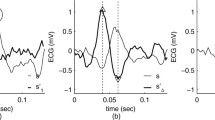Abstract
A new algorithm for QRS delineation has been developed. Based on the envelope of the e.c.g. signal a delineation function is defined, which yields a single positive pulse for each complex. From this function the onset and end of the QRS or, alternatively, a fiducial point is determined. To remove low-frequency component such as S-T abnormalities without distortion of the QRS complex, a filter with time-varying characteristics is used. The accuracy of the method has been evaluated in a test set of different QRS complexes obtained from coronary care patients. For QRS onset, the standard deviation of the difference between automated and manual determination was 7 ms in normal beats and 14 ms in ectopic beats. With simulated noise added to each waveform an average dispersion of 7 ms was observed in the recognition of the QRS onset at a signal-to-noise ratio of 15 dB. The corresponding dispersion in the location of a fiducial point was 2 ms. Using simulated e.c.g. data, the stability of the method is demonstrated for transitions between different waveform morphologies.
Similar content being viewed by others
References
Amazeen, P. G., Moruzzi, R. L. andFeldman, C. L. (1972) Phase detection ofR waves in noisy electrocardiograms.IEEE Trans.,BME-19, 63–66.
Anderson, C. N., Sanders, W. J. andHarrison, D. C. (1980) Comparing the morphologies of ECG waveforms in frequency space. InComputers in cardiology, IEEE Computer Society, 15–19.
Böckmann, R.-D., Dudeck, J., Weber, G. andKluss, D. (1977) Parametrisation of the templates for the detection of QRS-onset and-offset.Ibid., Computers in cardiology, IEEE Computer Society, 601–604.
Brekelmans, F. E. M. andde Vaal, C. D. R. (1981) A QRS detection scheme for multichannel ECG devices.Ibid., Computers in cardiology, IEEE Computer Society, 437–440.
Dillman, R., Judell, N. andKuo, S. (1978) Replacement of AZTEC by correlation for more accurate VPB detection.Ibid., Computers in cardiology, IEEE Computer Society, 29–32.
Gradman, A. H., Lewis, J. W. andMayer, J. L. (1980) An improved method for computer measurement of the R-R interval on the ambulatory electrocardiogram.Ibid. Computers in cardiology, IEEE Computer Society, 213–216.
Gymoese, E., Damgaard Andersen, J. andSandøe, E. (1978) Random access mass storage ECG-analysis system (RAMSES): A new system for quantitative analysis of long-term ECGs.Ibid. Computers in cardiology, IEEE Computer Society 221–224.
McClellan, J. H., Parks, T. W. andRabiner, L. R. (1973) A computer program for designing optimum FIR linear phase digitial filters.IEEE Trans.,AU-21, 506–526.
McClellan, K. M. andArnold, J. M. (1976) A QRS detection algorithm for computerized ECG monitoring. InComputers in cardiology, IEEE Computer Society, 447–450.
Mead, C. N., Moore, S. M., Spenner, B. F., Hitchens, R. E., Clark, K. W. andThomas Jr., L. J. (1978) Detection of multiform PCVs using a combination of time-domain and frequency domain informationIbid. Computers in cardiology, IEEE Computer Society, 343–346.
Murthy, I. S. N., andRangaraj, M. R. (1979) New concepts for PVC detection.IEEE Trans.,BME-26, 409–416.
Oppenheim, A. V., andSchafer, R. W. (1975)Digital signal processing. Prentice-Hall, New Jersey.
Rabiner, L. R. andSchafer, R. W. (1974) On the behaviour of minimax FIR digital Hibert transformers.Bell Syst. Tech. J.,53, 363–390.
Swenne, C. A., van Bemmel, J. H., Hengeveld, S. J. andHermans, M. (1973) Pattern recognition for ECG-monitoring: An interactive method for the classification of ventricular complexes.Comput. Biomed. Res.,5, 150–160.
Sörnmo, L., Börjesson, P. O., Nygärds, M.-E. andPahlm, O. (1981) A method for evaluation of QRS shape features using a mathematical model for the ECG.IEEE Trans.,BME-28, 713–717.
Thomas Jr., L. J., Clark, K. W., Mead, C. N., Ripley, K. L., Spenner, B. F. andOliver, C. G. (1979) Automated cardiac dysrhythmia analysis.Proc. IEEE,67, (9), 1322–1337.
Uijen, G. J. H., de Weerd, J. P. C. andVendrik, A. J. H. (1979) Accuracy of QRS detection in relation to the analysis of high-frequency components in the electrocardiogram.Med. & Biol. Eng. & Comput.,17, 492–502.
van Bemmel, J. H., Talmon, J. L., Duisterhout, J. S., andHengeveld, S. J. (1973) Template waveform recognition applied to ECG/VCG analysis.Comput. Biomed. Res.,6, 430–441.
Author information
Authors and Affiliations
Rights and permissions
About this article
Cite this article
Nygårds, M.E., Sörnmo, L. Delineation of the QRS complex using the envelope of the e.c.g.. Med. Biol. Eng. Comput. 21, 538–547 (1983). https://doi.org/10.1007/BF02442378
Received:
Accepted:
Issue Date:
DOI: https://doi.org/10.1007/BF02442378




